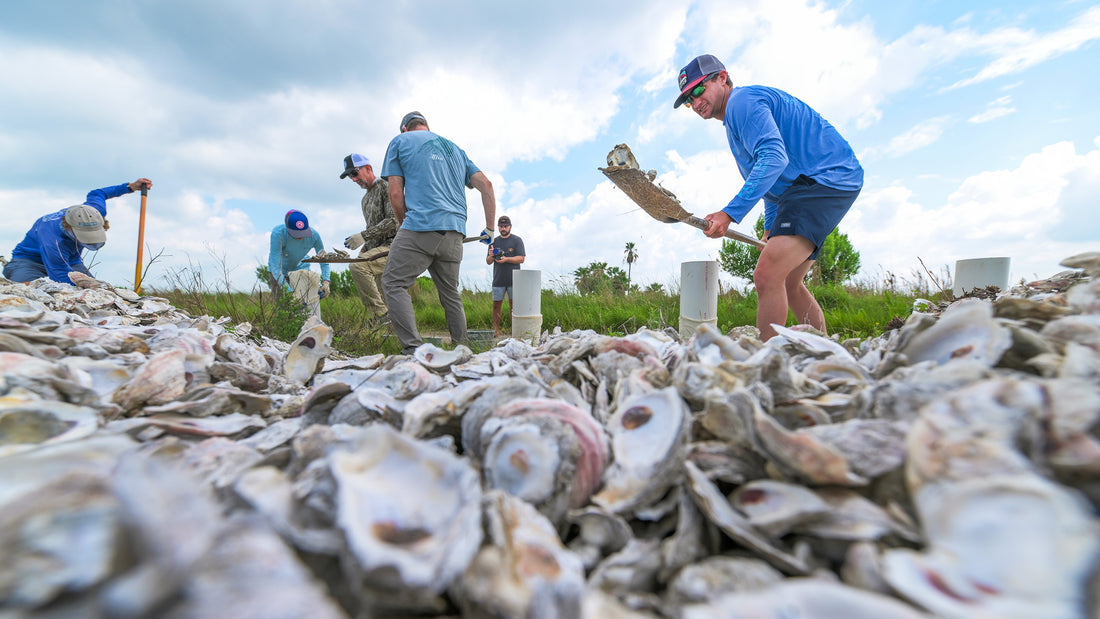
Why Oyster Conservation Matters For Anglers
What You Should Know About Oyster Reef Habitat
Oyster reefs are a critical component of the natural landscape, providing important services for our coastlines. It is estimated that only 15% of the world's oyster reef habitats are remaining.1
Our Goal: Protect and Restore Oyster Reefs
The oyster is so much more than just a fishery; it is a crucial foundational component of our coastal ecosystem – healthy oyster reefs mean a strong and sustainable coastline now and in the future.


Our oyster populations are hitting historic lows largely due to pollution, disease, overfishing and unsustainable harvesting methods. There are a number of ways you can join us to turn the tide on these issues. We’re partnering with the Coastal Conservation Association (CCA) to invest in the health of our oyster reefs for generations to come.
To learn more about our most recent oyster reef habitat restoration project with Mossy Oak and CCA, check out Rebuilding Reefs: The Oyster Project.
Why Do Oyster Reefs Matter for Anglers?
Oysters provide a stable environment for many fish species to flourish. Their protection ensures the longevity of the fisheries for the next generations of anglers. A few benefits to the angling community include:
Improved Water Quality: One oyster filters more than 50 gallons of water per day. One acre of oyster reef filters more than 36 olympic swimming pools. Along with improving the overall water quality, they ensure the health of our waters by preventing the overload of nutrients and algae growth.
Rich Habitat for Fish Species: Hundreds of marine aquatic species (300+) use oyster reefs for habitat, refuge, and food (Wells 1961). Oyster reef habitat supports nearly 4.5 times the aquatic biomass found in seagrass beds and roughly 11.5 times the aquatic biomass found in marsh edge habitat (Glancey et al. 2003).
Storm Surge & Sea Level Rise Prevention: Oysters are natural buffers against rising tides and storm surges created by extreme weather. They protect our shorelines and wetlands from erosion.
How Do Sanctuary Oyster Reefs Help Solve the Declining Population?
One way we can protect our oyster reefs is to encourage a certain amount of sanctuary oyster reefs where harvesting is prohibited to allow for the population to thrive. There is undeniable scientific justification for designating sanctuary oyster reefs. These reasons include:
- Providing seed sources for adjacent reefs
- Serving as habitat for hundreds of aquatic species
- Providing recreational fishing opportunities
- Offering numerous ecological benefits
- Determining currents
- Slowing water surges and shoreline erosion

What’s the Value of a Non-Harvested Oyster?
From an economic perspective, oyster habitat has incredible value. The estimated harvest value of oysters from degraded reefs is only $880 per acre.2 However, the estimated non-harvest value of oysters ranges from $2,000 all the way to $40,000 per acre.2 The estimated recreational fishing value of restored oyster reefs is $23,000 per acre.2 These economic gains come from several factors including:
- Providing habitat that increases biodiversity and fish production
- Reducing waves and stabilizing shorelines
- Improving water quality by filtering large volumes of water
- Producing oyster larvae that renourish harvested reefs
Texas on the forefront of Oyster Reef Conservation
Texas bays saw a commercial oyster harvest of over 2.6 million pounds in 2008, making it the second-largest in the U.S. However, they lacked effective methods to return shucked oyster shells to the bay waters, which is crucial for maintaining existing reefs and restoring degraded habitats. To address this issue, Harte Institute's “Sink your Shucks” program was launched in 2009. By spreading the word on environmental stewardship and offering educational resources to teachers and classrooms, this program focuses on helping the public understand the impact of recycling oyster shells and participating in oyster reef habitat restoration programs. With the help of more than 2,000 volunteers, the program has successfully placed over 3,200,000 pounds of shell in the bay, creating new oyster reef habitats.

CCA Texas Oyster Mariculture Program
CCA Texas has initiated an Oyster Mariculture Program aimed at reviving the dwindling oyster population in Texas bays. The program involves establishing a hatchery facility where oyster larvae are cultivated, nurtured in tanks, and eventually transferred to CCA Texas's designated oyster reefs. By raising oysters in the hatchery, the organization can boost the number of oysters available for reef restoration initiatives. Visit CCA Texas website to learn more about their Rescue Our Reefs mission.
How Can You Take Action Across the Country
Oyster restoration is important across much of the US coastline. Together, we need to prioritize the structural value of oyster reefs in the water by protecting existing reefs and working to create new ones. Join an oyster restoration project near you and help restore the foundation of our coastlines.

Participate in Oyster Recycling
Oyster restoration projects take an entire community. Planting more oyster reefs requires recycled oyster shells. After restaurants and individuals consume oysters, they can play a vital role in the process by recycling their shells. Once the oyster shells are recycled, they can be cleaned and cured over time so they are safe for reuse. Once they are ready to be reused, they can be seeded with oyster larvae and the community can come together to plant the oysters back into the ecosystem at an oyster habitat restoration event. There are many great organizations across the country working to address this issue. One place to start is to get involved with a local oyster restoration project near you at CCA.
1Beck Et Al (2011) And Lotze Et Al (2006)
2Grabowski et al. 2012 DOl: 10 1525/bio. 2012.6210.10: 2Carlton et al. 2016. TAMU- SG- 16- 211
Additional Resources
- https://www.harteresearch.org/collaboration/oyster-conservation
- https://www.fisheries.noaa.gov/national/habitat-conservation/oyster-reef-habitat
- https://www.billionoysterproject.org/shell-collection
- https://ccatexas.org/oysters/






